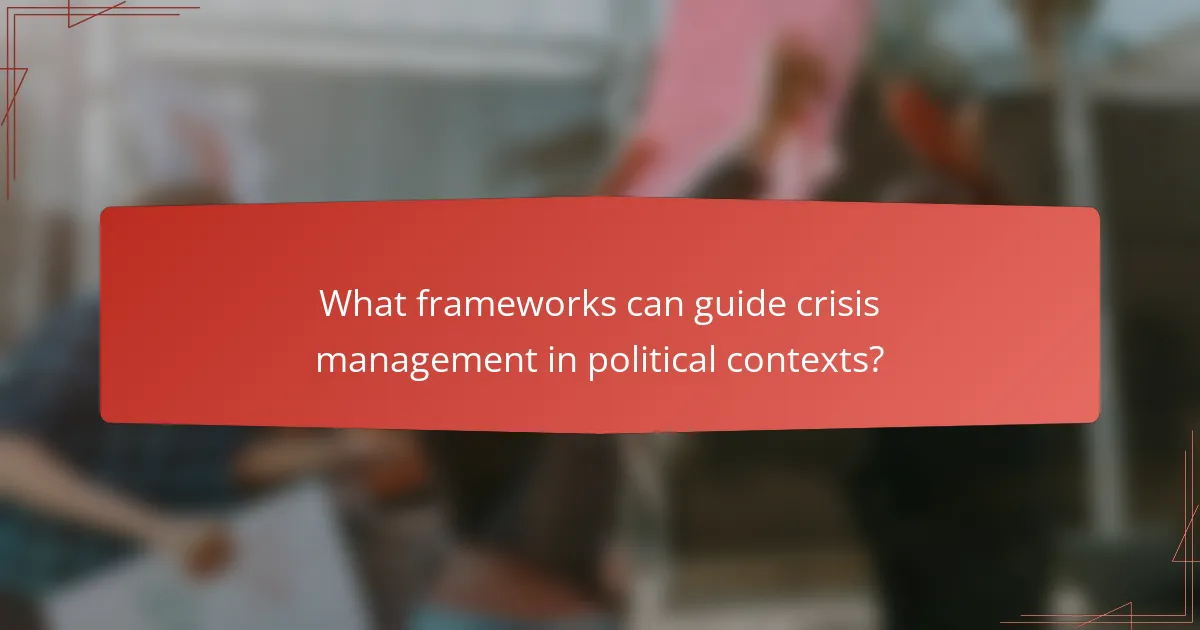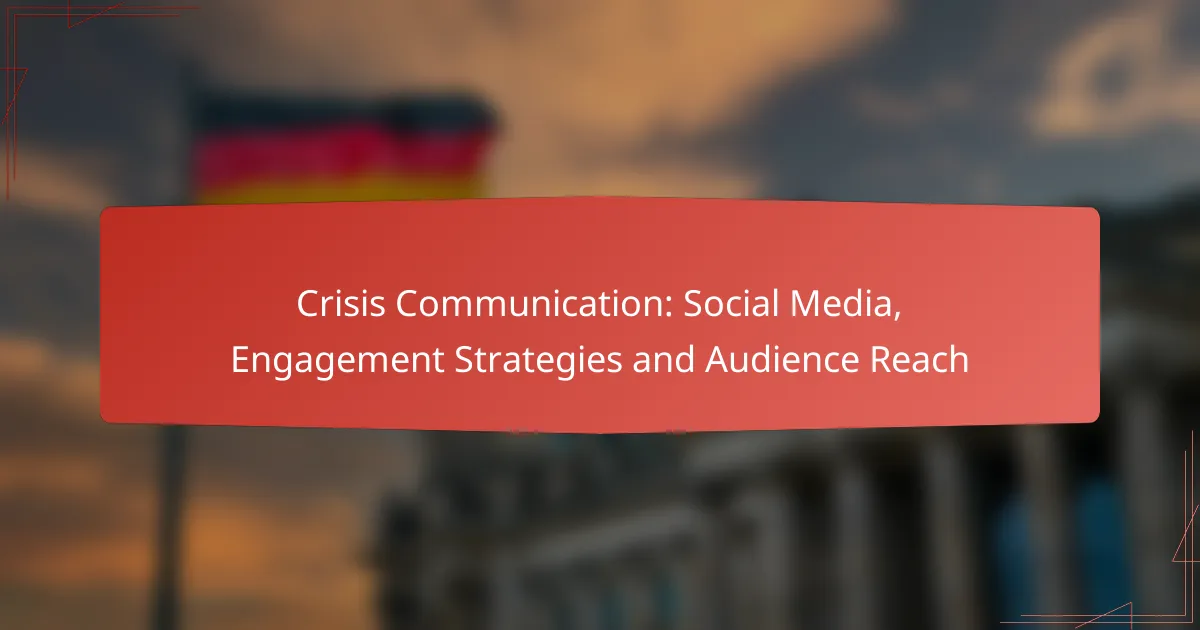Crisis management in political campaigns is crucial for maintaining public trust and credibility during unexpected challenges. Effective strategies involve proactive planning, swift responses, and consistent messaging to mitigate potential damage. Campaigns assess their effectiveness through public perception and media narratives, allowing them to adapt their approaches as needed. However, they must navigate challenges such as information overload and public distrust to uphold a positive image.

What are effective crisis management strategies in political campaigns?
Effective crisis management strategies in political campaigns involve proactive planning, quick responses, and consistent messaging to mitigate damage and maintain public trust. These strategies help campaigns navigate unexpected challenges and maintain their credibility with voters.
Proactive communication
Proactive communication involves anticipating potential crises and addressing them before they escalate. Campaigns should develop clear messaging and prepare responses to likely scenarios, ensuring that they can communicate effectively when issues arise.
For example, a campaign might issue statements on controversial topics to clarify their stance, reducing the chance of misinformation spreading. Regular updates to supporters can also build trust and demonstrate transparency.
Rapid response teams
Rapid response teams are specialized groups within a campaign dedicated to managing crises as they occur. These teams should be trained to act quickly, gathering information and crafting responses to minimize negative impacts.
Having a designated team allows campaigns to respond within minutes rather than hours, which is crucial in today’s fast-paced media environment. This team should include communication experts and legal advisors to ensure responses are both effective and compliant with regulations.
Social media monitoring
Social media monitoring is essential for identifying emerging issues and public sentiment in real-time. Campaigns should use tools to track mentions, hashtags, and trends related to their candidates and issues.
By staying informed about conversations online, campaigns can address misinformation promptly and engage with voters directly, helping to shape the narrative in their favor. Regular analysis of social media data can also inform future strategies and messaging.
Stakeholder engagement
Engaging stakeholders, including party members, donors, and influential community figures, is vital during a crisis. Keeping these groups informed and involved can help rally support and amplify the campaign’s message.
Regular briefings and open lines of communication can ensure that stakeholders feel valued and are prepared to defend the campaign if needed. This engagement can also help in mobilizing grassroots support during challenging times.
Message consistency
Maintaining message consistency is crucial in crisis management. All communications should align with the campaign’s core values and objectives to avoid confusion and mixed signals.
Campaigns should develop a messaging framework that outlines key points and tone, ensuring that all team members, from spokespeople to volunteers, deliver a unified message. Inconsistent messaging can lead to public distrust and further complicate crisis situations.

How do political campaigns assess crisis management effectiveness?
Political campaigns assess crisis management effectiveness through various methods that gauge public perception, media narratives, and engagement levels. These assessments help campaigns understand their response’s impact and adjust strategies accordingly.
Public opinion surveys
Public opinion surveys are a primary tool for evaluating how voters perceive a campaign’s crisis response. These surveys can reveal shifts in approval ratings, voter sentiment, and key issues that resonate with the electorate. Campaigns often conduct surveys before and after a crisis to measure changes in public opinion.
When designing surveys, it is crucial to include questions that specifically address the crisis and its handling. For instance, asking respondents to rate their confidence in the campaign’s leadership during the crisis can provide valuable insights. Regular tracking can help identify trends over time.
Media coverage analysis
Media coverage analysis involves examining how various outlets report on a crisis and the campaign’s response. This analysis can highlight the tone of coverage, the frequency of mentions, and the framing of the narrative. Positive coverage can bolster a campaign’s image, while negative reports may necessitate strategic adjustments.
Campaigns should monitor both traditional and social media to understand public discourse. Tools like media monitoring services can assist in tracking sentiment and identifying influential voices that shape public opinion. Analyzing the reach and engagement of media stories can also inform future communication strategies.
Engagement metrics
Engagement metrics provide insights into how effectively a campaign communicates during a crisis. Metrics such as social media shares, comments, and likes can indicate public interest and approval of the campaign’s messaging. High engagement levels often correlate with a successful crisis response.
Campaigns should focus on key performance indicators (KPIs) like response time, message clarity, and audience interaction. For example, a rapid response that generates significant online discussion can signal effective crisis management. Regularly reviewing these metrics allows campaigns to refine their strategies and improve future responses.

What are the common challenges in crisis management for political campaigns?
Crisis management in political campaigns often faces several key challenges that can significantly impact effectiveness. These challenges include information overload, public distrust, and resource limitations, all of which require careful navigation to maintain a positive campaign image.
Information overload
Information overload occurs when an excessive amount of data and messages flood the public and media channels, making it difficult for campaigns to communicate effectively. This can lead to confusion and misinterpretation of the campaign’s message, especially during a crisis.
To manage information overload, campaigns should prioritize clear, concise messaging. Using bullet points or infographics can help distill complex information into digestible formats, ensuring that key points are communicated without overwhelming the audience.
Public distrust
Public distrust can severely hinder a political campaign’s ability to respond to crises. When voters feel skeptical about a candidate’s integrity or motives, they are less likely to accept the campaign’s explanations or solutions.
Building trust requires transparency and consistent communication. Campaigns should acknowledge mistakes openly and provide clear, factual information to counter misinformation. Engaging with the public through social media can also help rebuild trust by demonstrating accountability and responsiveness.
Resource limitations
Resource limitations, including budget constraints and staffing shortages, can restrict a campaign’s ability to effectively manage crises. Smaller campaigns may struggle to respond quickly or engage in extensive outreach, making it challenging to mitigate negative impacts.
To optimize limited resources, campaigns should focus on strategic partnerships and leverage volunteers for outreach efforts. Prioritizing key messages and targeting specific voter demographics can also maximize impact without requiring extensive resources.

What role does social media play in crisis management for political campaigns?
Social media is crucial for crisis management in political campaigns, enabling rapid communication and engagement with voters. It allows campaigns to address issues promptly, counter misinformation, and maintain a connection with their audience during critical moments.
Real-time communication
Real-time communication through social media platforms allows political campaigns to respond instantly to crises. This immediacy helps shape narratives and mitigate damage by providing accurate information directly to constituents. For example, a campaign can issue a statement on Twitter within minutes of a controversy, ensuring their perspective is heard before misinformation spreads.
To effectively utilize real-time communication, campaigns should monitor social media channels continuously. Setting up alerts for mentions and relevant keywords can help identify emerging issues quickly. A proactive approach can prevent small issues from escalating into larger crises.
Viral misinformation control
Controlling viral misinformation is essential for maintaining a campaign’s credibility during crises. Social media can amplify false narratives, making it critical for campaigns to address inaccuracies swiftly. They can counter misinformation by sharing fact-checks, clarifying statements, and engaging with users who spread false information.
Campaigns should develop a strategy for identifying and responding to misinformation. This includes training staff to recognize false claims and creating shareable content that debunks myths. Collaborating with fact-checking organizations can also enhance credibility and provide authoritative responses.
Audience engagement
Audience engagement on social media fosters a sense of community and trust during crises. By actively interacting with supporters, campaigns can reassure voters and maintain loyalty. Engaging content, such as live Q&A sessions or polls, can help gauge public sentiment and address concerns directly.
To enhance audience engagement, campaigns should prioritize transparency and authenticity. Regular updates about the crisis and the campaign’s response can keep supporters informed and involved. Additionally, encouraging user-generated content can amplify positive messages and strengthen community ties.

What frameworks can guide crisis management in political contexts?
Effective crisis management in political contexts can be guided by several frameworks that emphasize communication, strategy, and stakeholder engagement. These frameworks help political campaigns navigate challenges by providing structured approaches to decision-making and public interaction.
Situational Crisis Communication Theory (SCCT)
SCCT posits that the response to a crisis should be tailored based on the situation’s specifics, including the nature of the crisis and the organization’s prior reputation. By categorizing crises into types, such as victim, accidental, or preventable, campaigns can select appropriate communication strategies to mitigate damage.
For example, a campaign facing a scandal may adopt a defensive strategy if the crisis is deemed preventable, while a natural disaster response might focus on empathy and support. Understanding the context allows for more effective messaging and public relations efforts.
Image Repair Theory
Image Repair Theory focuses on restoring a political figure’s reputation after a crisis. It includes strategies such as denial, evasion of responsibility, reducing offensiveness, and corrective action. Campaigns must assess which strategy aligns with their situation and audience perception.
For instance, if a candidate is accused of misconduct, they might deny the allegations or emphasize their positive contributions to the community. The choice of strategy can significantly influence public perception and voter trust.
The Four Stages of Crisis Management
The four stages of crisis management are prevention, preparation, response, and recovery. Each stage requires distinct actions and considerations to effectively manage a crisis in a political campaign. Prevention involves identifying potential risks and implementing measures to avoid crises.
Preparation includes developing communication plans and training staff. During the response phase, timely and transparent communication is crucial. Finally, recovery focuses on restoring public trust and learning from the crisis to improve future responses.
Stakeholder Engagement Framework
This framework emphasizes the importance of engaging with stakeholders, including voters, media, and party members, during a crisis. Effective engagement can help maintain support and mitigate backlash. Campaigns should identify key stakeholders and tailor their communication strategies accordingly.
For example, direct outreach to supporters through social media or town hall meetings can foster a sense of community and transparency. Listening to stakeholder concerns and addressing them promptly can also enhance credibility and trust during turbulent times.


